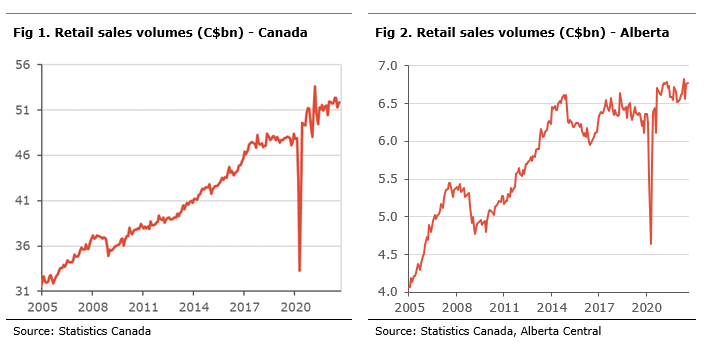Economic insight provided by Alberta Central Chief Economist Charles St-Arnaud.
Bottom line
Retail sales rose in August after some weakness in July. Nevertheless, with the preliminary estimate suggesting a decline in September, retail sales likely peaked in June. So far this year, retail sales have mainly increased because of inflation. In real terms, or adjusted for inflation, retail sales are little changed. This suggests that consumers are not increasing their consumption level.
The outlook for retail sales and consumer spending more broadly remains tilted to the downside. On one side, consumers’ finances are being squeezed by an erosion in purchasing power due to high inflation and rising interest rates (see The Great Consumer Squeeze for more details on how those factors affect households). On the other side, households have accumulated a significant amount of saving during the pandemic. So far, it seems households are using their accumulated savings to maintain their spending levels and compensate for the higher cost of living, rather than increase it.
In Alberta, retail sales have outperformed slightly relative to the rest of the country over the past year. However, we note that core retail sales, excluding motor vehicle dealers and gasoline stations, have been stronger than in other parts of Canada in recent months, suggesting some softening consumer spending in the province. It is too soon to say whether this situation will persist. We also note continued divergence in retail sales between the metropolitan areas and the rest of the province, with sales stronger in Calgary and Edmonton so far this year. This could be explained by more robust employment gains relative to the rest of the province in the metropolitan areas.
Retail sales rose 0.7% m-o-m in August. Compared to the same month last year, retail sales rose +7.0% y-o-y. Statistics Canada also reports that retail sales dropped by 0.5% m-o-m in September based on a preliminary estimate.
Monthly sales increased in 6 out of 11 subsectors. On the month, the rise in retail sales resulted mainly from higher sales at food stores (+2.4% m-o-m), motor vehicle and parts dealers (+0.6% m-o-m), health and personal care stores (+0.9% m-o-m), and sports and hobby stores (+5.0% m-o-m). In addition, Statistics Canada notes that the surge in spending on sporting goods in August was likely the result of the resumption of organized sports after a two-year hiatus due to the pandemic. These increases were partly offset by declines at general merchandise stores (-0.3% m-o-m), gasoline stations (-0.2% m-o-m) and clothing and footwear stores (-0.1% m-o-m). Core retail sales, which excludes motor vehicles and parts and gasoline stations, rose by 0.9% m-o-m (+7.4% y-o-y).
In volume terms (i.e. adjusted for inflation), retail sales increased by 1.1% in August (+0.5% y-o-y) and core retail sales are up by 0.4% on the month (+1.9% y-o-y). The increase in volume shows that higher inflation was only a minor source of growth in retail sales.
In Alberta, retail sales were flat in August (+9.7% y-o-y). Retail sales were mixed across sectors. Big decline at gasoline stations (-8.7% m-o-m), clothing and footwear stores (-5.9% m-o-m), and general merchandise stores (-2.3% m-o-m) were offset by strong gains at motor vehicle and parts dealers (+9.3% m-o-m), building material and garden centres (+8.1% m-o-m) and health and personal care stores (+6.6% m-o-m).
Core retail sales declined by 1.9% m-o-m (+3.9% y-o-y) in August. Although there are no official volume details at the provincial level, we estimate that retail sales volumes in the province rose by 0.3% m-o-m (+2.9% y-o-y).
Statistics Canada has recently started to release retail sales numbers for Calgary and Edmonton. The data shows some small divergence between regions. As such, retail sales in Edmonton increased 19.2% y-o-y (10.9% YTD), while its was weaker in Calgary (+9.0% y-o-y and 7.1% YTD) and the rest of the province (+6.5% y-o-y, +1.5% YTD). The relative volatility in the data makes it hard to determine the exact cause of divergences in retail sales between regions. However, the recent employment reports suggest that the recovery in the labour market has been stronger in Calgary and Edmonton over the past year than in the rest of the province and could explain part of the outperformance of the metropolitan areas.



Independent Opinion
The views and opinions expressed in this publication are solely and independently those of the author and do not necessarily reflect the views and opinions of any organization or person in any way affiliated with the author including, without limitation, any current or past employers of the author. While reasonable effort was taken to ensure the information and analysis in this publication is accurate, it has been prepared solely for general informational purposes. There are no warranties or representations being provided with respect to the accuracy and completeness of the content in this publication. Nothing in this publication should be construed as providing professional advice on the matters discussed. The author does not assume any liability arising from any form of reliance on this publication.
Alberta Central member credit unions can download a copy of this report in the Members Area here.